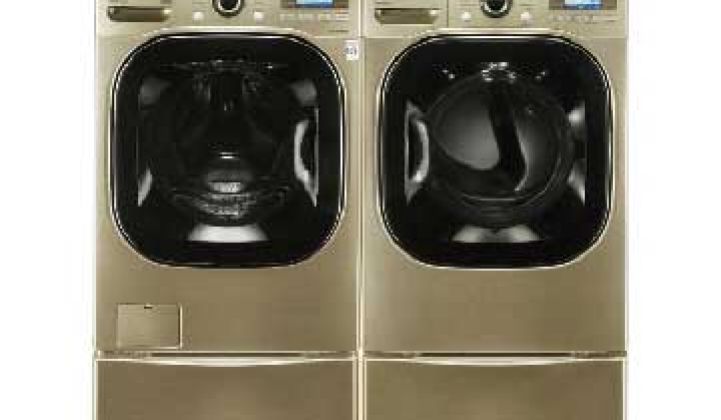Not too far in the future, the refrigerator will be able to tell you if your food is spoiling or text you if you left the door open. A robotic vacuum can feed the dog. The washing machine can steam dry your clothes overnight. Additionally, many of these next generation appliances will also be able to communicate back to smart meters to take signals from utilities and turn themselves on at night when energy prices are low, or enable homeowners take part in demand response programs.
Intelligent people working across the smart grid space regularly tout the promise of smart appliances. The cheerleaders argue that it is just this sort of technology that will seamlessly allow the average American to reap some of the benefits of the smart grid. People will be able to enroll in programs to save energy while saving money. It all sounds glorious. But it’s being completely oversold.
Smart appliances are cool -- very cool. The first wave coming on the market this year is also very, very expensive. It will likely be years, if not decades, before these models make it into the bulk of American homes. New EnergySTAR appliances, often far more affordable though less intelligent, are significantly more efficient than their counterparts from even five or 10 years ago. It is far more likely that products like electric vehicles and plug-in hybrids, which are currently only trickling into a few garages, will reshape the average person's relationship with their utility more than a Wi-Fi-enabled dishwasher.
The broad gains that can be had through improving efficiency for most appliances do far more for peak shaving than the ability to shift the loads to the evening. Standards that have been in place since the 1980s have reduced peak demand by at least 15 percent compared to the situation that would exist if there had been no standards, according to the Appliance Standards Awareness Project.
While there is a coolness quotient and a convenience factor that will come with the ability to set the dryer or defrost cycle to run at night, the advantage of these machines communicating to the utility is limited, because, with a few exceptions, appliances simply aren’t the energy hogs they used to be.
“How many do you have to control to get some real benefits?” asks Andrew deLaski, Executive Director of the Appliance Standards Awareness Project. “If you’re talking about fridges and dishwashers, you’re going to have to touch an awful lot of them.”
A regular top-loading washing machine on the market (EnergySTAR Qualified, but priced the same as many that are not) uses about 160 kWh per year -- at an estimated cost of $12 to $17 annually. Fancier appliances that are more efficient and/or have technology to wash clothes as well in cold water as they can in hot water use even less energy. Top-of-the-line models can easily run into the thousands of dollars.
Offering smart features is often about differentiation, and not about cost savings or smart grid capabilities, according to deLaski. He says the real price of appliances has not increased substantially in the last few decades and so manufacturers are looking for other ways to make their products shine on the showroom floor.
If the cost is low enough, Wi-Fi or ZigBee-enabled communications capabilities will be put into most models sooner than later. In the short term, however, most consumers will make purchases based on EnergySTAR ratings and other smart features, and not based on whether the dishwasher can talk to the utility. For some buyers, the tipping point may be just one cooler add-on.
One area where standards -- and potentially, smart features -- could have more impact is in air conditioning. Central AC is the single biggest electricity user in most homes, and the models today already use 30 percent less than models from 2000. New standards are coming in June that will cut that figure by another 8 percent, said deLaski.
Even with the latest standards, communications devices that would allow utilities to adjust air conditioning compressors could reap real benefits for peak shaving. The Sacramento Municipal Utility District is doing just that. Dave Watson, Smart Grid Lead at Lawrence Berkley National Laboratory, said they were working on pilots with SMUD to cycle compressors off while leaving the fans running in 20-minute increments so that comfort wasn’t sacrificed. It is these sorts of no-brainer home smart appliance applications that are likely to get market uptake in coming years.
Another area where vast improvements in standards could reap tangible benefits for peak, without people having to do anything, is water heaters, according to deLaski. Standards that were issued by the Department of Energy last year will address some of those issues, he said.
The increased efficiency achieved through standards improvement holds a lot of promise. DeLaski noted that although refrigerators have gone through five new standards since the late 1970s, the most recent one still saw another 25 percent improvement from the preceding standard. “There is the potential for additional improvement” across most appliances even today, he said.
Would a Wi-Fi chip in each and every appliance in America help shave peak if everyone participated? Sure. Should these new and expensive appliances be held up as the convergence of smart grid and the home? Probably not. The choice, control and visibility that consumers will have with new home technologies in coming years are not to be underestimated -- just don’t hold up the smart dishwasher as the finest example of them all. Besides, efficiency improvement might be easier than changing consumer behavior. “The standards are going to happen,” said deLaski, “and they’re going to develop peak savings.”
In the meantime, at least the vacuum can remember to feed the dog.



